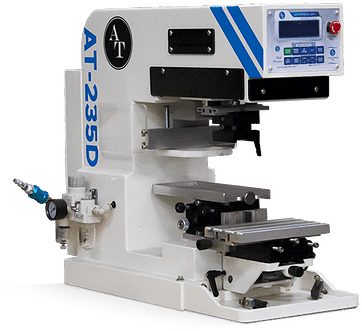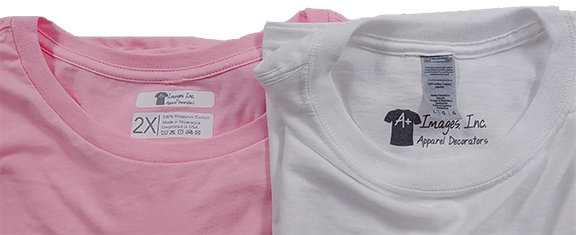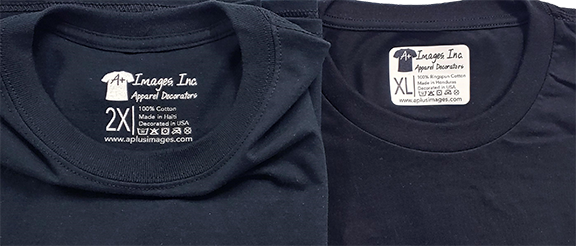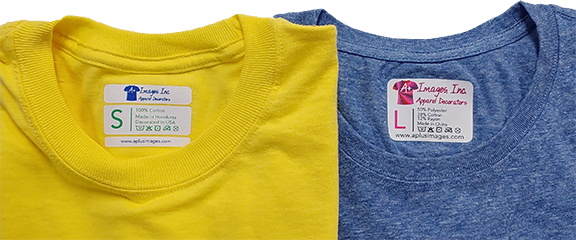Tagless Label Printing
Tagless Label Printing Overview
One of the hottest trends in the decorated apparel market is tagless label printing. Also known as custom shirt tags or custom branding, this process allows you to replace or supplement the tags the manufacturer attaches to the shirt with your own logo or fully-detailed tag. Tagless label printing differentiates your brand from the competition and helps customers identify you. Keep reading to learn about tagless label printing methods and requirements.
Four Methods of Tagless Label Printing
We offer four methods of tagless label printing. This allows you to choose the best option for your business model and budget.
Pad Printing
Our newest option is pad printing. It should become the most popular tagless label print method we offer. This type of printing allows a 2D image engraved in a plate to be transferred to a 3D object (the shirt in this case) via a silicone pad. Another way to describe it is to think of an automated stamp. First, ink fills into the engraved plate. Next, a silicone pad picks up the image. Then, it moves over and stamps it onto the garment.
Printed labels are available using black or white ink. Custom ink colors can be ordered. The print area has a 2.5″ diameter circle size limit. Your design MUST stay within the dotted circle line. Single color, 300 DPI, vector artwork is required. You can download a tagless label template for pad printing here. The file can be imported into Adobe Illustrator, Corel Draw, or other vector-based graphics software for editing.
There is a one-time setup fee to burn each plate. Additionally, there is a per-print charge. Current pricing can be found here. A new plate is needed for each different tag. Details on this are explained in the “Shirt & FTC Requirements” section below.
Pad printing is also a great alternative option for other branding techniques. For example, we can print a sleeve or back neckline of a shirt with a one-color company logo. This would help increase your brand’s visibility on a garment. Additionally, pad printing is great for printing masks! Pad printing is ideal for 24-500 of exact same print, especially on a repeat basis.
DTG Printing
First, we print and dry the front of the shirt. Then, we turn your shirt inside-out, print the tagless label, and dry it again. A new file is needed for each different tag. Details on this are explained in the two “requirements” sections below. As a result, this option is best when printing small quantities of the same tagless label, or when many different tag files are needed. See our DTG page for more information. The DTG tagless label method is a good option when printing less than 24 of the same exact tag.
Screen Printing
Screen printed tags are exactly what they sound like. First, we print the front of your shirt and dry it. Then, we turn your shirt inside out and print your tag directly onto the garment. For more information, check out our screen printing page for details on the process. This is the best option when printing 500 or more of the same exact, one-color tagless label.
Heat transfer printing
We offer two options for heat transfer tagless labels: screen printed and print-and-cut vinyl. Screen printed transfers work best for one-color designs. Print-and-cut vinyl transfers work great for both multi-color designs and extremely detailed text/graphics. Screen printed transfers can be directly printed on the garment. On the other hand, print-and-cut vinyl transfers will be printed on a white decal that will be applied to the shirt using a heat press.
Both options work best when buying bulk transfers up front. The more transfers you purchase in advance, the lower the costs are per label or transfer. When a shirt is ordered, we apply the tag (current heat press rates apply per shirt). This tagless label option requires a detailed plan in advance so you make the right type of transfers ahead of time. Pricing is quoted on a case-by-case basis. This option works best when you can purchase a large amount of transfers in advance, but only have shirts printed in small groups or individually. For example, this option may work well with occasional to frequent, one-off, fulfillment orders.
Our AT-235D Pad Printer & tagless printed label examples.




Shirt & FTC Requirements
There are three major requirements for tagless label printing. First, the shirt must use a tear-away label. We cannot erase or cover over a shirt that already has a printed tag. Additionally, we do not remove sewn-in tags, nor do we sew in tags for any garments. When you view products in our online catalogs, shirt styles that feature tear-away labels clearly list this feature. Click here for an example of what to look for when searching for an ideal garment with tearaway tags.
Second, the garment must be cotton and/or polyester. Blends also work. This includes 50/50 cotton/poly, 60/40 cotton/poly, tri-blends, 100% cotton, and 100% polyester. However, we cannot print on nylon or shirts chemically treated for water or stain resistance. Furthermore, we cannot print tags on jackets, hats, scarves, dress shirts, etc.. Our tagless label printing system is designed for t-shirts, tanks, long-sleeve t-shirts, some sweatshirts/hoodies, and other similar garments.
Finally, there are federal FTC regulations to consider. Full details on these requirements can be found here. The full read is worth if this is something you want to pursue. In summary, tags are required to list key information below:
- Company Name
- Shirt Size
- Fabric Content
- Washing Instructions
- Country of Origin
Additional info may also be added. For example, a company logo, slogan/tagline, and website are acceptable additions.
Tagless Label File Requirements
The FTC requirements can make the tagging process difficult for many small brands and clothing lines. Most shirts are made from a variety of fabrics and offer many sizes. Additionally, garments (even the same style number) can be made in different countries. This combination of factors results in the need for a LOT of different tag templates or files. Take the G200 t-shirt from Gildan, for example. It comes in eight (8) sizes (S-5XL), has four (4) different blends (100% cotton, 99% cotton/1% polyester, 90% cotton/10% polyester, and 50% cotton/50% polyester), and is made in at least four (4) different countries (Dominican Republic, Haiti, Honduras, & Nicaragua).
If you were to remove the tags to replace with your own, you would need up to 128 tag files or templates using a one color-tag! That only covers one style from one brand! When you add in other styles from other brands, you could end up needing hundreds or thousands of different tags to legally tag your product line. This works fine for huge manufacturers like Hanes and Fruit of the Loom that make millions of shirts per year. However, it is not ideal for small clothing brands. While this option is the most professional-looking, it is also the most expensive. Fortunately, there are two ways around this!
The Workarounds
People come in a wide range of shapes and sizes. Additionally, everyone has different tastes. It wouldn’t be practical to only offer a a few sizes of one style shirt just for the sake of limiting tag templates. Therefore, a more realistic option would be to source brands offering multiple product lines that are “Made in the USA”. For example, American Apparel, Bella+Canvas, and US Blanks all make shirts in the USA. Assume you have a product line of 100% cotton, “Made in the USA” shirts in all available colors and sizes S-3XL from American Apparel. You would only need six tag templates for pad printing or screen printing (12 for DTG or transfers) to label all your shirts. While this option is the most professional-looking, it is also expensive. Luckily, there is a second option.
The alternative option is ideal for most customers. For instance, you can purchase shirts that have two tear-away tags. One tag has the brand logo on it. The second tag contains all the required legal info. Major brands such as Anvil, Bella + Canvas, & Next Level offer dual tear-away tags. We simply remove the brand logo tag and print a new logo on the inside neck of the shirt. This allows each company to only require one or two files (for light and dark shirts). This is the most affordable way to custom-brand your shirts.
Important Notices
When supplying your own garments for decorating and/or tagless label printing, it is critical that you do not remove any tags before bringing the garments to us. We will not print or label any garments that do not arrive to us legally tagged! Additionally, it is also important to know that you many not remove any of the legally required info from garments after picking up completed items from us, unless you replace it with the proper information. Only the end-user (your customer) can completely remove tags!
Finally, please note that custom tagging will increase the order turnaround time. The amount of time will vary by customer needs. For example, shirts only getting a logo printed will require less time than shirts than get fully detailed customized tags. For the latter, we will need to sort the shirts and figure out all the necessary tag templates for each order. Furthermore, the time will increase if we need to make new tag templates. Having pre-made heat transfer labels or only printing a logo will significantly help increase production speed.
Not buying what we are selling? Here’s a great story about one company’s run in the FTC.
Contact us to get start on your custom tagless label printing project today!
